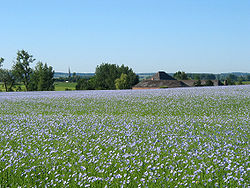


Farming is growing crops and keeping animals for food and raw materials. Farming is a major part of agriculture.



Farming is growing crops and keeping animals for food and raw materials. Farming is a major part of agriculture.
Farming started thousands of years ago, but no one knows for sure how old it is.[1] The development of farming gave rise to the Neolithic Revolution as people gave up nomadic hunting and became settlers in cities.
Farming and domestication probably started in the Fertile Crescent (the Nile Valley, the Levant and Mesopotamia).[2] The area called Fertile Crescent is now in the countries of Iraq, Syria, Turkey, Jordan, Lebanon, Israel, and Egypt. Wheat and barley are some of the first crops people grew.
Cotton was domesticated in Peru by 4200 BC.[3]
Livestock including horses, cattle, sheep, and goats were taken to the Americas, from the Old World. The first of those horses, came with the Spanish conquistadors[4] (or soldiers and explorers) in the 1490s. Moving those cattle, sheep, goats and horses, were part of the Columbian Exchange.
People probably started agriculture by planting a few crops, but still gathered many foods from the wild. People may have started farming because the weather and soil began to change. Farming can feed many more people than hunter-gatherers can feed on the same amount of land.
This allowed the human population to grow to such large numbers as there are today.[5][6]
Many people still live by subsistence farming, on a small farm. They can only grow enough food to feed the farmer, his family, and his animals. The yield is the amount of food grown on a given amount of land, and it is often low. This is because subsistence farmers are generally less educated, and they have less money to buy equipment. Drought and other problems sometimes cause famines. Where yields are low, deforestation can provide new land to grow more food. This provides more nutrition for the farmer's family, but can be bad for the country and the surrounding environment over many years.
In some countries, farms are often fewer and larger. During the 20th century they have become more productive because farmers are able to grow better varieties of plants, use more fertilizer, use more water, and more easily control weeds and pests. Many farms also use machines, so fewer people can farm more land. There are fewer farmers in rich countries, but the farmers are able to grow more.
This kind of intensive agriculture comes with its own set of problems. Farmers use a lot of chemical fertilizers, pesticides (chemicals that kill bugs), and herbicides (chemicals that kill weeds). These chemicals can pollute the soil or the water. They can also create bugs and weeds that are more resistant to the chemicals, causing outbreaks of these pests. The soil can be damaged by erosion (blowing or washing away), salt builddup, or loss of structure. Irrigation (adding water from rivers) can pollute water and lower the water table. These problems have all got solutions, and modern young farmers usually have a good technical education.
Farmers select plants with better yield, taste, and nutritional value. They also choose plants that can survive plant disease and drought, and are easier to harvest. Centuries of artificial selection and breeding have changed crop plants. The crops produce better yield. Fertilizers, chemical pest control, and irrigation all help.
Some plants are improved with genetic engineering. One example is modifying the plant to resist herbicides.
Farms may also keep animals. That is called animal husbandry. If they are used to make meat for people to eat, that is livestock production. Non-meat animals, such as milk cows and egg-producing chickens, are kept for their produce. "Produce" here means their eggs and milk, which are sold by the farm, usually in markets. Large animals need grassland of some kind for grazing. What they need depends on the animals. Goats eat a much wider range of plants than cows. In some parts of the world, that makes goats a more sensible choice for a farmer than cows.

It is important for there to be enough food for everyone. The food must also be safe and good. People say it is not always safe, because it contains some chemicals. Other people say intensive agriculture is damaging the environment. For this reason, there are several types of agriculture.
Agricultural policy means the goals and methods of agricultural production. Common goals of policy include the quality, amount, and safety of food.
There are some serious problems that people face trying to grow food today. These include:
There are also difficulties with the distribution of food:
In produced weight, these crops are the most important (global production in metric tonnes):[7]
The figure for sugarcane is rather deceptive. It omits sugar beet, but includes the weight of the woody stalk. Most of the plants which produce food are in the grass family Poaceae.
| Crop | 2000 | 2013 | 2020 |
|---|---|---|---|
| Sugarcane | 1,256,380 | 1,877,110 | 1,870,246 |
| Rice | 599,355 | 745,710 | 1,264,410 |
| Maize | 592,479 | 1,016,740 | 1,171,332 |
| Wheat | 585,691 | 713,183 | 760,931 |
| Potato | 327,600 | 368,096 | 359,124 |